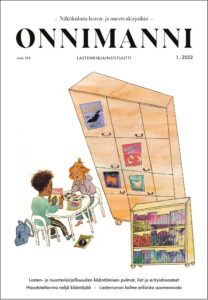
This year’s first issue of Onnimanni is dedicated to the translation of fiction for children and young adults.
For several years now, the number of Finnish originals has slightly exceeded the number of translations for young people. From the point of view of a small language, this is good news. However, the range of translated languages and books translated from the major languages is now significantly narrower than before. In her editorial, Päivi Heikkilä-Halttunen considers the effects of this trend.
Providing interesting case examples, translator Alice Martin shows the importance of immersing oneself in the text when translating. Translators have an impact on the development of children’s language and sense of aesthetics, as well as on their emotional life and ability to empathise. Alice Martin has e.g. translated two of Lewis Carroll’s Alice-books into Finnish.
Onnimanni asked three experienced translators to translate a Swedish-language children’s poem by Henrika Andersson into Finnish. Juhani Lindholm’s, Hannele Huovi’s and Tuula Korolainen’s translations and accounts of their translation processes show how translators of poetry must balance off several compromises, linguistic nuances and rhythmical considerations against each other.
Sirkku Latomaa has interviewed two translators of Finnish-language children’s literature, Iwona Kiuru who translates into Polish, and Nil Deniz Çidanli who translates into Turkish. Challenges often arise in terms of humour, language play or even Finnish holiday traditions, which cannot be directly translated into the target language and culture.
Riitta Oittinen and Eliisa Pitkäsalo focus in their research article on issues of power related to children’s literature. Also translators integrate or alienate texts based on predominant ideologies and values. Hence translators – along with publishers, authors and parents – serve as a kind of censors. Differently illustrated versions and translations of children’s books always influence how these texts are interpreted and understood. Every version reveal how texts are continuously reshaped according to the set of values within a particular society.
In the 1950s and 60s children’s literature translated into Finnish drew extensively on ideas and trends within Nordic networks. Laura Leden showed this in her doctoral thesis defended last year, and in her article in Onnimanni she relates e.g. the cooperation between publishing houses Rabén & Sjögren and WSOY through their respective children’s literature editors Astrid Lindgren and Inka Makkonen. Many American series books were at the time translated into Finnish via Sweden.
Päivi Heikkilä-Halttunen has interviewed Raija Rintamäki and Tuomas Nevanlinna, who both have had long careers as translators of children’s literature. Rintamäki is specialized in picturebooks and easy to read children’s books. Nevanlinna showed his talent for translating nonsense with Roald Dahl’s Iso kiltti jätti (transl. 1989 from The BFG, 1982) when he studied each word’s connotations and etymology in order to be able to translate all the word play and nonsense twists. Both translators would like critics of children’s books to pay more attention to the work carried out by the translator. Often and at best, the translator’s work is so good that no-one notices it!
J. R. R. Tolkien’s idea that young people cannot, because of their age and limited reading inexperience, conceptualise fantasy worlds has long been considered a guiding principle for children’s and young adult fantasy literature. Markku Soikkeli presents, however, new research which shows that children in fact have special abilities to access fantasy worlds. Child readers today may even have a lower threshold to enter strange worlds than adult readers.
Marjo Jääskä presents the Multilingual Library located in Pasila, Helsinki. The library houses books in over 80 languages, which can be borrowed from all over Finland via their interlibrary loan services. During the past two years, the library has especially focused on expanding their range of books for young people.
Elisa Repo and Juli-Anna Aerila’s Lukutikku-article, targeted to professional educators, presents various methods to promote literature within multilingual groups. More than ever before, day-care centres and schools need information on how to include linguistic awareness into their literary education.
The Seula-column includes e.g. reviews of two new international collections of articles on translating literature for young people. The Puntari-column features reviews of books for children and young adults currently translated into Finnish.
This expanded special issue was made possible by a grant from The Finnish Association of Translators and Interpreters.
Translation Maria Lassén-Seger
